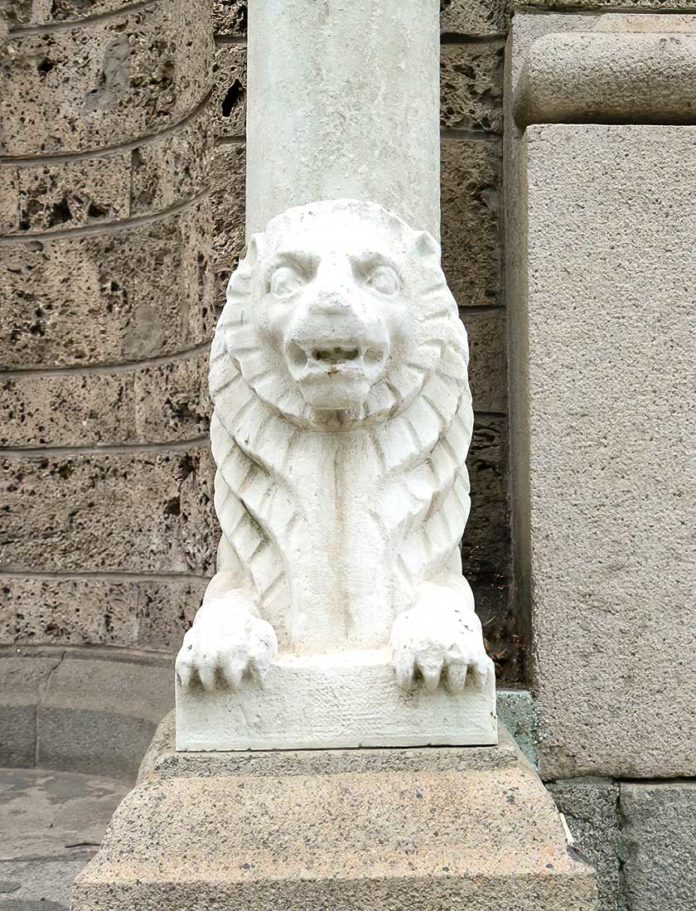The lion has long been a powerful symbol in Bulgarian history. It represents strength, courage, and resilience. This iconic emblem has evolved over centuries, reflecting the nation’s journey. Originating from ancient times, the lion’s image has developed and adapted, maintaining its relevance today. This proud symbol adorns significant landmarks and monuments, such as the National Assembly building, Tsarevets Fortress in Tarnovo, the Shipka Monument, and various monuments in Sofia and Ruse. Join us as we explore the rich heritage of the lion in Bulgaria, illustrated through captivating photos.
Bulgaria’s Coat of Arms: The Lions of Strength and Unity

Bulgaria’s coat of arms, displayed on the National Assembly building in Sofia, embodies the nation’s identity and heritage. At its center, a shield features a powerful lion rampant, a symbol deeply rooted in Bulgarian history.
Flanking the shield are two more lions, standing proudly and reflecting the strength and resilience of the Bulgarian people. These lions, depicted in classic heraldic style, exude majesty and vigilance, representing bravery, nobility, and Bulgaria’s enduring spirit.
Above the shield, a crown signifies Bulgaria’s sovereignty and historic monarchy. Below, the motto “Съединението прави силата” (“Unity Makes Strength”) underscores the importance of solidarity in national progress.
The coat of arms, with its trio of lions, shows the evolution of this symbol from ancient origins to modern significance. Each element is meticulously crafted, showcasing Bulgaria’s artistic talent and cultural heritage.
Admire the coat of arms on the Old National Assembly building, and you witness a powerful reminder of Bulgaria’s rich history and the lion’s enduring role as a symbol of strength and unity.
Location: Sofia | The Old National Assembly Building in Sofia on the Map
The Lions of the Courthouse in Sofia
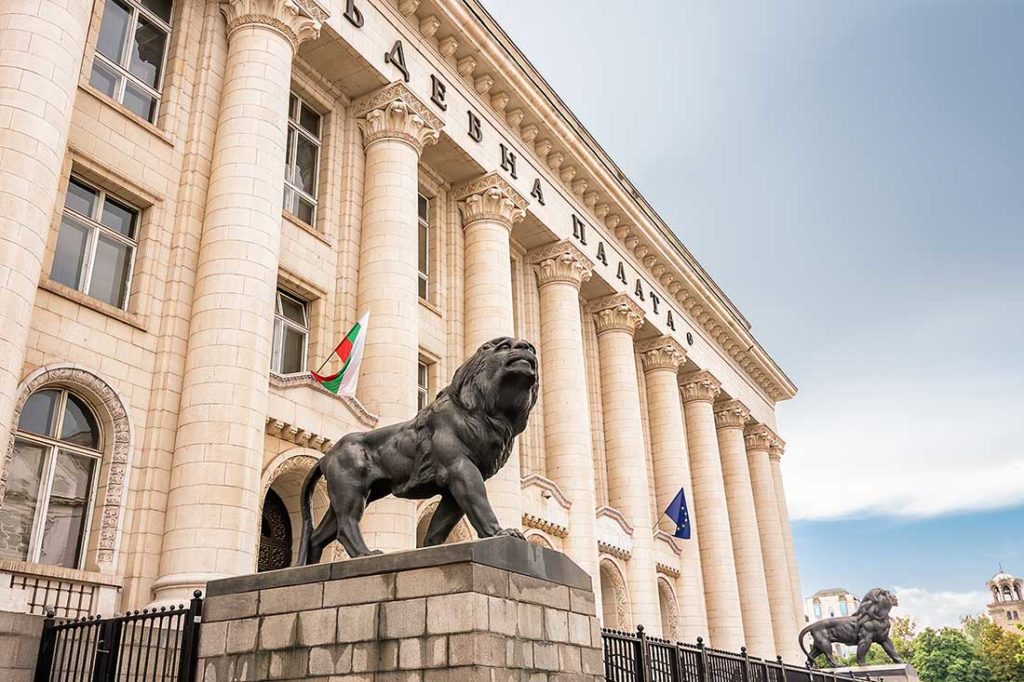
In front of the Sofia Courthouse stand two imposing lion statues, symbols of justice, strength, and vigilance. These majestic sculptures guard the entrance to Bulgaria’s most important judicial buildings and embody the values of law and order.
Each lion is meticulously crafted, with powerful muscles and fierce expressions that command respect. Their stance is one of readiness as if prepared to defend the principles of justice at any moment. Positioned on sturdy pedestals, these lions are more than decorative elements; they are emblematic of the strength and integrity of the Bulgarian judicial system.
The National Palace of Justice, built between 1929 and 1940, with its grand neoclassical architecture, provides a fitting backdrop for these symbols of power. The building itself, with its tall columns and ornate details, reflects the importance of the judicial system in Bulgarian society. The lions, standing proudly in front, reinforce this message, serving as a constant reminder of the rule of law.
The lions inspire confidence and security as you walk past the National Palace of Justice. Their presence is a testament to Bulgaria’s commitment to justice and the enduring power of the lion as a national symbol. These statues enhance the building’s aesthetic appeal and enrich Sofia’s cultural and symbolic landscape.
Location: Sofia | The Courthouse on the Map
The Lion Sculptures on the Roof of the National Theatre Ivan Vazov in Sofia

Two striking lion sculptures, part of a grand metal composition, are perched atop the National Theatre Ivan Vazov roof in Sofia. The roof itself is dome-shaped and painted green, adding a touch of elegance to this iconic building. These impressive sculptures depict three lions pulling a chariot at the roof’s peak.
A woman stands in the chariot, symbolizing the spirit of the theater. She holds a mask in one hand, representing theater’s dual nature of comedy and tragedy. Her other hand, raised high towards the sky, grasps a goad, a traditional tool used to drive horses, symbolizing guidance and control.
This powerful imagery conveys the dynamic and commanding nature of the performing arts. The lions, embodying strength and power, are harnessed to the chariot, symbolizing the raw, untamed energy the theater channels and directs. As the driver of this chariot, the woman represents the guiding force of artistic expression and creativity, steering the formidable power of the lions toward meaningful and impactful performance.
This sculptural ensemble not only adds a dramatic flair to the theater’s architecture but also encapsulates the essence of the theatrical arts. It signifies how the strength and passion of the arts are guided by human creativity and vision, leading to profound and stirring performances.
As you gaze up at these magnificent sculptures on the roof of the National Theatre Ivan Vazov, you are reminded of the powerful role of the arts in society and the enduring symbolism of the lion as a source of strength and inspiration.
Location: Sofia | The National Theatre Ivan Vazon on the Map | Website
The Lions of the Liberty Monument in Ruse
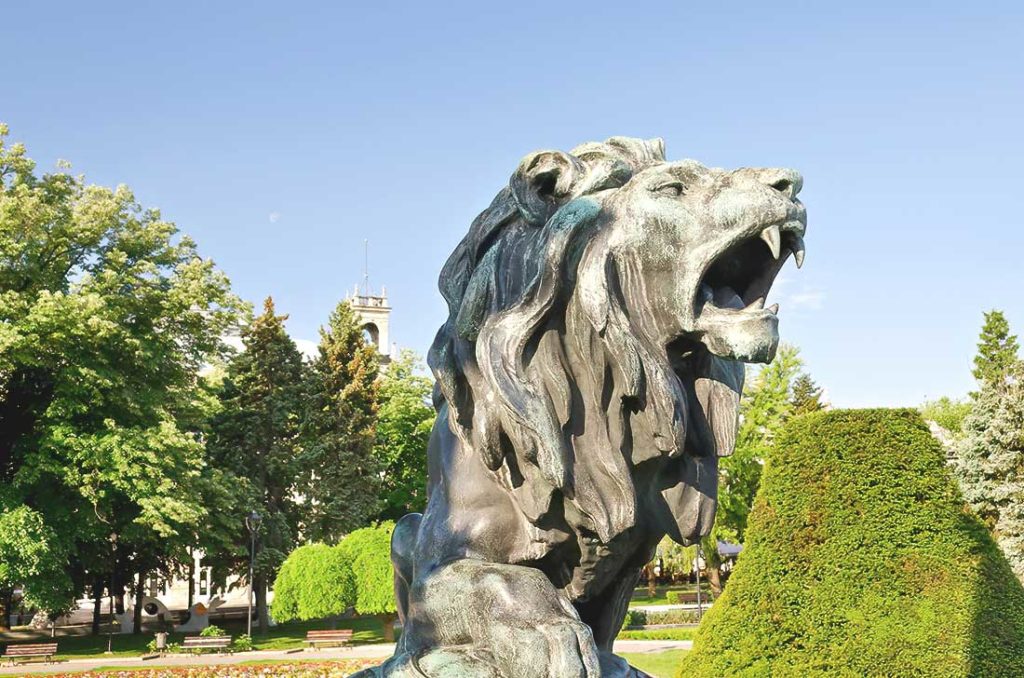
The Liberty Monument in Ruse is an absolute symbol of the city and one of the most beautiful monuments in Bulgaria. Rising to a height of 17.80 meters, the monument features a 3.75-meter bronze statue at its peak. This statue crowns a monumental pyramid consisting of a base, pedestal, column, and statue.
At the base, two striking lion sculptures guard the monument. One lion fiercely tears apart slave chains with its mouth, symbolizing the breaking free from oppression. The other lion protects a shield and sword, embodying the defense of freedom. These powerful images convey the struggles and triumphs of Bulgaria’s fight for independence.
The monument, designed by the renowned Italian sculptor Arnoldo Zocchi, was completed in 1908 and officially inaugurated in 1909. It stands as a testament to the dedication and sacrifices of Bulgarian freedom fighters. The two lions continue to inspire visitors with their dynamic poses and fierce expressions, reminding them of the enduring spirit of liberty.
As you admire the Liberty Monument, the lions’ sculptures encapsulate the bravery and resilience that define the Bulgarian quest for freedom. These meticulously crafted symbols resonate with locals and visitors, keeping the spirit of independence alive in the heart of Ruse.
Location: Ruse | The Liberty Monument in Ruse on the Map
The Lion Sculpture at the Entrance of Tsarevets Fortress in Veliko Tarnovo

A magnificent lion sculpture guards the entrance to Tsarevets Fortress in Veliko Tarnovo. The lion symbolizes the city’s liberation from Ottoman rule and is a powerful emblem of strength and resilience.
The first version of the lion sculpture, installed in 1918, commemorated the 10th anniversary of Bulgaria’s independence. Created by artist Dimitar Bagrilov, this cement lion sat on a pedestal of hewn stone blocks. However, due to deterioration, it was removed in 1935.
In 1936, a new lion, made of white Arbanasi stone, replaced the original. Italian stonemason Pietro Sacchetti carved this second lion, continuing the legacy of Bagrilov’s design. This sculpture deteriorated over time and was removed after September 9, 1944.
The current lion, installed on September 17, 1998, marks the 90th anniversary of Bulgaria’s independence. Crafted from white Vratsa sandstone by Professor Nenko Marov and his students, this lion stands 165 cm tall and weighs 3.5 tons. Modeled after photographs of the original, this sculpture is a robust symbol of Bulgarian pride and heritage.
The lion at Tsarevets embodies power, authority, and national pride. It reflects Bulgarian culture’s wisdom, justice, tranquility, and nobility values. As you approach Tsarevets Fortress, these lions are a powerful reminder of the nation’s enduring strength and historical significance.
Location: Veliko Tarnovo | Tsarevets Fortress on the Map | Website
The Lion Sculptures at the Lion’s Bridge in Sofia

Lion’s Bridge in Sofia, known for its iconic lion sculptures, was built between 1889 and 1890. It replaced the old Stone Bridge over the Vladaya River, connecting the city with the new railway station. The bridge symbolizes the modernizing spirit of the young Bulgarian capital city.
Designed by Czech engineer Václav Prošek, the bridge features four magnificent lion sculptures cast in Vienna, costing 260,000 golden leva. These lions sit proudly on granite pedestals at each corner of the bridge, exuding strength and majesty.
One legend says the sculptor, who considered the lions his perfect creation, discovered they had no tongues after being cast. Devastated by this flaw, he reportedly took his own life. Despite this tragic tale, the lions remain a powerful symbol of Sofia’s resilience and growth.
The lions arrived in Sofia in 1891, enhancing the bridge’s architectural and symbolic significance. Today, Lion’s Bridge is a testament to Mayor Dimitar Petkov’s foresight and its creators’ craftsmanship, marking a significant period in Bulgaria’s urban development.
Location: Sofia | The Lion’s Bridge on the Map
The Lion Sculpture at the Shipka Monument in Bulgaria
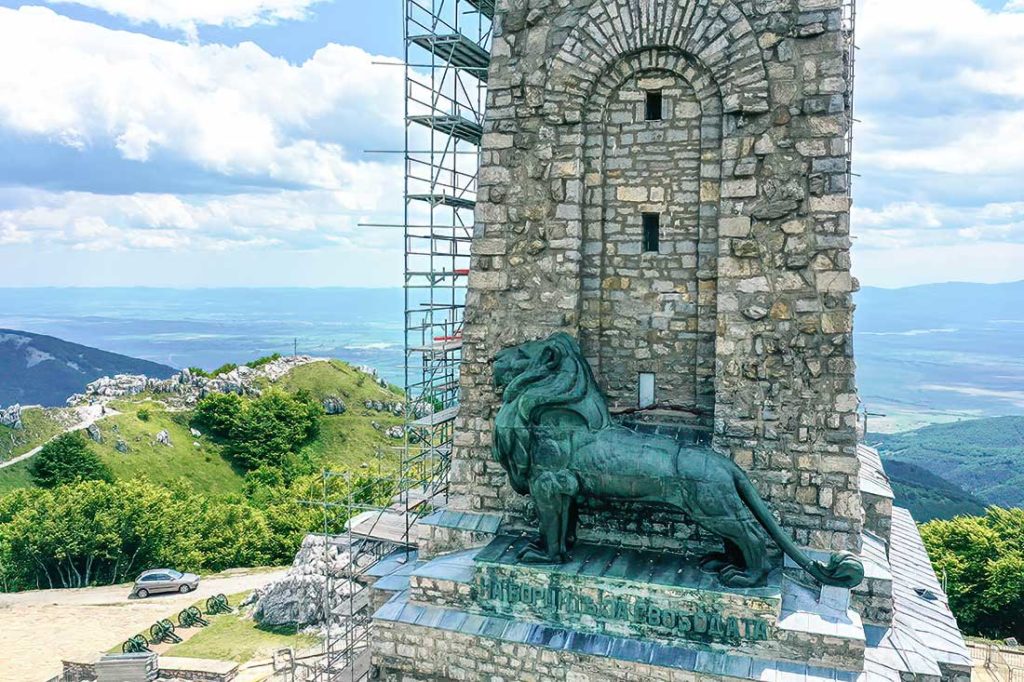
The Shipka Monument, also known as the Monument of Liberty, is crowned by an impressive lion bronze sculpture. This monument, located on St. Nikola Peak (Shipka Peak), commemorates the heroic battles of the Russo-Turkish War and the liberation of Bulgaria.
Initially, the plan was to place an enormous bronze lion atop the truncated pyramid-shaped tower facing north. This lion was crafted from 28 bronze shells and weighed 28 tons. The journey to transport the lion to the top involved mules and donkeys. However, political pressures from neighboring countries influenced the lion’s final orientation.
Romania protested the northward-facing lion, fearing territorial implications. Consequently, Greece, Turkey, and Serbia reacted, changing the lion’s direction multiple times. Ultimately, the decision was made to have the lion face east.
The Shipka monument, constructed from dolomite stone, stands 31.5 meters tall. Above the entrance, the colossal brass lion measures 8 meters in length and 4 meters in height and weighs around 12 tons. It comprises 53 separate pieces and symbolizes Bulgaria’s strength and endurance.
Built between 1926 and 1930, the monument was designed by architect Atanas Donkov and sculptor Alexander Andreev, with the lion sculpture created by sculptor Kiril Shivarov. On its sides, the monument features inscriptions of major battle sites – Shipka, Stara Zagora, and Sheynovo. The tower offers a panoramic view of the Shipka Pass and surrounding areas, providing a poignant reminder of Bulgaria’s fight for freedom.
Just below the Shipka Monument is another monument complex featuring an additional lion sculpture. This lion, depicted in the photo below, is carved robustly and stylized. It is holding a shield and symbolizing protection. The lion is shown breaking chains, symbolizing liberation from oppression. This sculpture, positioned on a stone wall, complements the monument above, further emphasizing freedom and resilience.

Location: St. Nikola Peak (Shipka Peak) | The Shipka Monument on the Map
The Lion Sculpture at the Vasil Levski Monument in Karlovo

The Vasil Levski Monument in Karlovo honors one of Bulgaria’s greatest national heroes. Erected between 1903 and 1907, the statue by sculptor Marin Vasilev stands over 8 meters tall.
Levski, the Apostle of Freedom, holds a revolver in his right hand. On his left, a majestic lion represents strength and freedom.
The lion, sculpted with meticulous detail, exudes power and vigilance. Its posture, with one paw slightly raised and head held high, represents courage and readiness to defend. The lion sculpture beside Levski enhances the monument’s symbolism, reminding visitors of Bulgaria’s enduring spirit and the fight for independence. The combination of Levski and the lion encapsulates the nation’s pride and resilience.
Location: Karlovo | The Vassil Levski Monument in Karlovo on the Map
The Lion Sculpture at the Monument of the Unknown Soldier in Sofia

The lion sculpture at the Unknown Soldier Monument in Sofia embodies the Bulgarian spirit. Renowned sculptor Andrey Nikolov worked on it from 1926 to 1931.
In a sphinx-like pose, the lion measures 4 meters long and symbolizes Bulgaria’s youth and strength. It appears calm and poised, ready for a sudden leap.
Initially, the lion-faced opposition for its peaceful demeanor. Critics preferred a roaring, upright lion as the national symbol. Despite challenges, Nikolov completed the monument in 1936, with support from Tsar Boris III.
Today, the lion faces the Alexander Nevsky Cathedral, polished by children who play on it. The statue can be viewed from all sides, symbolizing openness and resilience. After several relocations, it now stands proudly, embodying Bulgaria’s enduring strength and spirit.
Location: Sofa | The Monument of the Unknown Soldier in Sofia on the Map
The Lion Sculpture at the Soldiers’ Memorial in Front of NDK
The bronze lion sculpture at the Soldiers’ Memorial in front of the National Palace of Culture (NDK) in Sofia symbolizes Bulgaria’s rich military history and national pride. Initially installed in 1934, this iconic lion statue pays tribute to the First and Sixth Infantry Regiments, known as Sofia’s “Iron Division”, who fought bravely in Bulgaria’s wars for national unification.
In November 2017, the lion sculpture was restored and reinstalled at its original location, marking the revival of a critical historical monument. After being stored for years at the National Museum of Military History, the lion was returned to its rightful place, thanks to the efforts of the Sofia Municipality and the decision made by the Sofia City Council in 2014 to bring back this important piece of history. The restoration included reinstating commemorative plaques listing the names of soldiers who sacrificed their lives for their country.
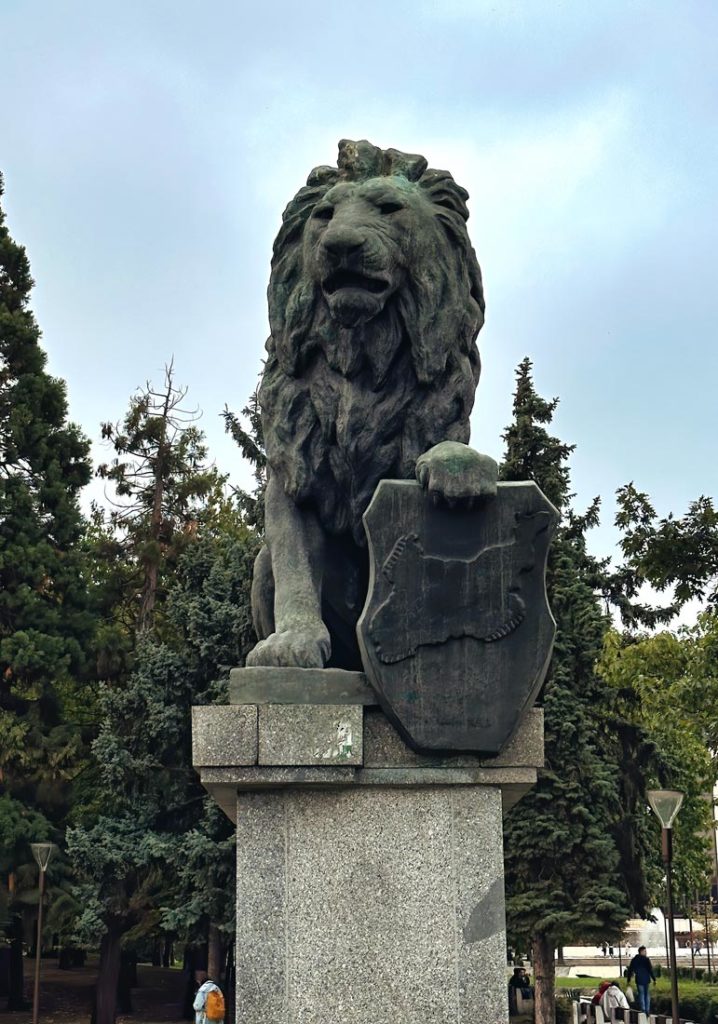
History of the Soldiers’ Memorial and the Lion Sculpture
The original memorial was inaugurated in a grand ceremony by King Boris III in 1934, following the efforts of Mayor Ivan Ivanov and various military organizations. They aimed to ensure that every town in Bulgaria had a monument honoring its soldiers. The lion statue, a creation of sculptor Mihail Mihaylov, represents the Bulgarian people’s strength, courage, and resilience.
The monument’s commemorative plaques honor the First and Sixth Infantry Regiments, which played significant roles in Bulgaria’s military history. These regiments fought bravely in key battles during the Serbo-Bulgarian War of 1885 and the wars for national unification from 1912 to 1918.
The First Infantry Sofia Regiment originates in the Bulgarian Volunteer Corps, earning fame in battles like Shipka and Stara Zagora. Over time, this regiment became one of Bulgaria’s most celebrated military units. Similarly, the Sixth Infantry Tarnovo Regiment, formed in 1884, gained a fierce reputation, with Colonel Boris Drangov famously stating, “wherever the Tarnovo Regiment steps, grass does not grow”. Both regiments contributed significantly to Bulgaria’s military legacy, and their memory is enshrined in the memorial at NDK.
Restoration of the Memorial at NDK
The 2017 restoration of the lion sculpture and surrounding memorial marks a crucial moment in preserving Bulgaria’s military heritage. Plans to fully restore the memorial complex were set for 2018, with a competition to enhance the monument and ensure it remains a lasting tribute to the soldiers’ heroism and sacrifice.
Location: Sofia | Lion Monument, Soldiers’ Memorial
With their rich symbolism and historical significance, the lions of Bulgaria stand proudly across the nation. These majestic sculptures, from Sofia to Shipka, are just a few examples of the many lion figures throughout the country. They are enduring reminders of Bulgaria’s strength, resilience, and cultural heritage.
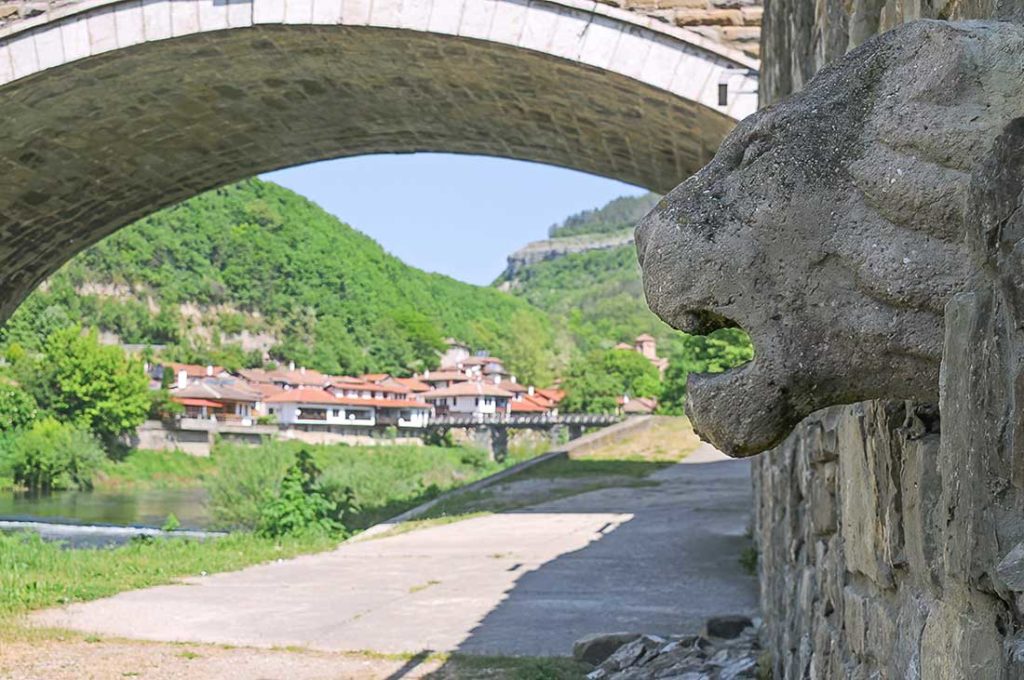
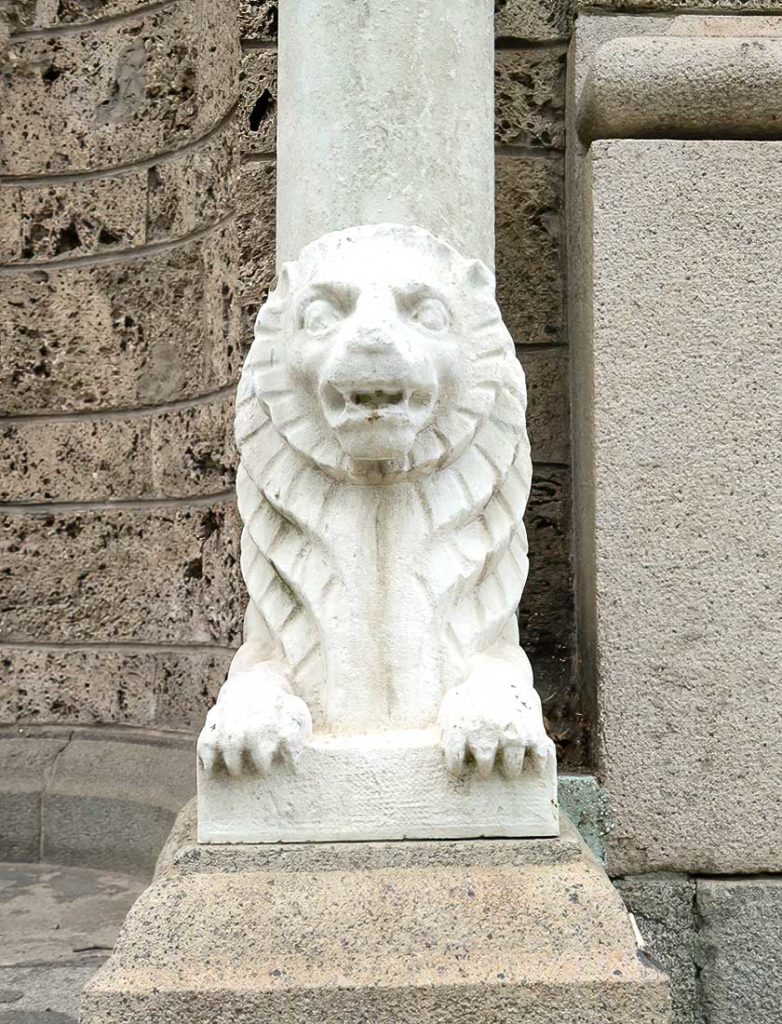
For more captivating insights into Bulgaria’s rich cultural landscape, explore our article “Hidden Gems of Bulgaria: Aesthetic Details“.


